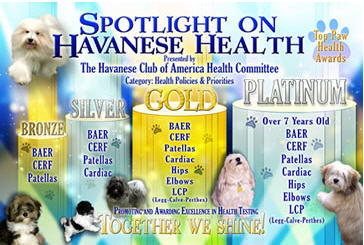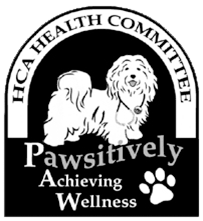
The Havanese is a healthy breed overall with relatively few serious health issues. The Havanese Club of America, as the AKC Parent Club for Havanese, serves as caretaker and protector of the breed. To fulfill that role, we take pride in a proactive health program led by an active Health Committee functioning in an advisory role on matters related to the health and welfare of the Havanese.

Here in the Health section of the Havanese Club of America website, you can learn more about:
- The innovative Top Paw Health Award system developed by the Havanese Club of America to encourage widespread health testing. Recognition is awarded not only to those dogs whose owners have health tested them at various levels, but also to those breeders and stud dog owners who are health testing their own Havanese in addition to mentoring other Havanese fanciers to encourage them to health test their Havanese.
- Our relationship with other leading health organizations such as the AKC Canine Health Foundation (AKCCHF), the Canine Health Information Center (CHIC.
- Common canine health issues included in our extensive health testing programs are summarized in a HavaneseHealth Testing Flyer which may be downloaded and printed for quick reference.
![]() Ocular Abnormalities - 92.9% Normal*
Ocular Abnormalities - 92.9% Normal*
*Source - Canine Eye Registration Foundation (CERF) 2006 Havanese Statistics Report for Eye Disease
- Definition - any condition for which the Havanese would not receive a passing CERF exam (primarily cataracts but also including rare cases of optic nerve coloboma, retinal atrophy, retinal dysplasia and lens luxation/subluxation)
- Diagnosis - annual CERF exam
- CERF exam which should be performed every year until age 7
- Verify CERF online at OFA website here
- Verify CERF online at VMDB website here
![]() Congenital Deafness – 99.7% Normal**
Congenital Deafness – 99.7% Normal**
**Source - Orthopedic Foundation for Animals (OFA) online breed statistics 12/2012
- Definition - Congenital deafness in dogs can be acquired [caused by intrauterine infections, ototoxic drugs like gentamicin, liver disorders, or other toxic exposures before or soon after birth] or inherited. Inherited deafness can be caused by a gene defect that is autosomal dominant, recessive, sex-linked, or may involve multiple genes (more on this later). Within the Havanese breed, there have been reports of unilateral deafness and much less frequently of bilateral deafness.
- Diagnosis - Brainstem Auditory Evoked Response (BAER) testing performed at a BAER testing facility with results sent to OFA for OFA certificate.
- Available over 7 weeks of age
- Verify BAER testing online at OFA website here
![]() Patellar Luxation – 97.1% Normal**
Patellar Luxation – 97.1% Normal**
**Source - Orthopedic Foundation for Animals (OFA) online breed statistics 12/2012
- Definition - The patella, or kneecap, is part of the stifle joint (knee). In patellar luxation, the kneecap luxates, or pops out of place, either in a medial or lateral position..
- Diagnosis - veterinary exam sent to OFA for OFA certificate number
- Available at 1 year of age
- Verify patella testing online at OFA website here
![]() Cardiac – 99.3% Normal**
Cardiac – 99.3% Normal**
**Source - Orthopedic Foundation for Animals (OFA) online breed statistics 12/2012
- Definition - Malformation of the heart or great vessels
- Diagnosis - cardiac auscultation by a veterinary cardiologist, veterinary internist or general practice veterinarian
- Available at 1 year of age
- Verify cardiac testing online at OFA website here
![]() Hip Dysplasia – 89.2% Normal Hips**
Hip Dysplasia – 89.2% Normal Hips**
**Source - Orthopedic Foundation for Animals (OFA) online breed statistics 12/2012
- Definition - Literally, this is faulty or abnormal development of the hip and is a genetic condition causing laxity of the hip joint which in turn may lead to various degrees of arthritis (also called degenerative joint disease, arthrosis, osteoarthrosis).
- Diagnosis - hip radiographs sent to OFA for rating
- Preliminary rating available at 1 year of age
- Permanent rating and OFA number available over 2 years of age
- Verify hip testing online at OFA website here
![]() Elbow Dysplasia – 92.9% Normal**
Elbow Dysplasia – 92.9% Normal**
**Source - Orthopedic Foundation for Animals (OFA) online breed statistics 12/2012
- Definition -An inherited, polygenic disease in the dog's elbow. May consist of one or more than one of these conditions: Pathology involving the medial coronoid of the ulna (FCP), Osteochondritis of the medial humeral condyle in the elbow joint (OCD) or Ununited anconeal process (UAP).
- Diagnosis - elbow radiographs sent to OFA for rating
- Preliminary rating available at 1 year of age
- Permanent rating and OFA number available over 2 years of age
- Verify elbow testing online at OFA website here
![]() Legg-Calve-Perthes – 99.9% Normal**
Legg-Calve-Perthes – 99.9% Normal**
**Source - Orthopedic Foundation for Animals (OFA) online breed statistics 12/2012
- Definition - Blood supply to the femoral head in the hip joint is interrupted, which in turn leads to avascular necrosis, or the death of the bone cells.
- Diagnosis - hip radiographs sent to OFA for rating
- Available at 1 year of age
- Verify Legg-Calve-Perthes testing online at OFA website here
The HCA participates in the Canine Health Information Center (CHIC) program to promote testing and reporting of health test results for the Havanese breed. CHIC is a centralized canine health database jointly sponsored by the AKC/Canine Health Foundation (AKC/CHF) and the Orthopedic Foundation for Animals (OFA). Testing required for a Havanese to receive a CHIC certificate include OFA BAER, OFA Hips, OFA Patellas and annual CERF exams. It is not necessary for the Havanese to actually pass those tests as our intent with the CHIC program is to simply encourage widespread testing and the open disclosure of results through the OFA database.
HCA encourages Havanese breeders to use the OFA database to research the health pedigree of dogs prior to breeding. This provides an outstanding research tool for performing searches on individual dogs and also links health testing results of the dog’s related pedigree information (Parent, Offspring, and Sibling) , when those related dogs have been health tested.
It is fair to assume the vast majority if not all breeders have good intentions, as no one sets out to breed unhealthy dogs. Each breeder faces similar challenges as we work to translate good intentions into producing healthy puppies. Appropriate utilization of available information along with a continued commitment to health testing and research will ensure we meet our common goal ‘to encourage and promote quality in the breeding of purebred Havanese’.
Please
Rafe Schindler, Chair
Members: Sara Dellorto, Kim Gillette, Kathy King, Lucy Lancaster, Joan Little

|
Rationale for Individual Dog Award Changes: The Bronze Paw award now consists of tests which can be completed at one year of age to provide encouragement for younger dogs and their owners to begin a healthy habit of health testing and to continue down the road towards further health testing in later years.The Silver Paw award adds OFA Cardiac, another test available to owners after their dog has reached one year of age. The Health Committee recognizes that Cardiac may be an area of concern which we wish to monitor and by encouraging a broad base of cardiac testing within our breed we hope to assist owners in making prudent breeding decisions and to gain more data with which to judge the extent of any problem which may exist. The committee realizes that a single test performed as early as one year of age will not exclude later development of cardiac issues but feels this is a step in the right direction to gather preliminary data. We fully expect to modify cardiac testing at some point in the future to require periodic testing as the dog ages but would first like to have more data on which to base that decision. The Gold Paw award adds orthopedic testing which is available for OFA certification after age two. By grouping hips and elbows together, it will be easy for owners to obtain both tests in a single visit to their vet, will limit the number of times the dog might possibly need to be sedated for the x-rays and will offer a price incentive at most vets for doing both tests together. Elbow was added in order for owners to rule out elbow dysplasia which does seem to exist at some level within our breed and to also provide the Health Committee with a more statistically significant level of testing so that we can more fully assess any ongoing health issues with elbow dysplasia. OFA Legg-Calve-Perthes certification is available at no cost if a dog has received a passing hip grade and the owner sends in the appropriate form to OFA after receiving that passing hip certificate. Again, there have been isolated reports of LCP within our breed. The Platinum Paw award is designed to provide special recognition to our Veteran dogs and their owners who have continued to health test. The age of seven was chosen as the cutoff for the last passing CERF certificate since that was originally recommended by Dr. Kirk Gelatt as the age to differentiate between heritable cataracts and those which would be considered to be attributed to normal age related changes. Top Paw Award Requirements: Stud Dog must have sired 10 or more offspring who qualify for the Gold Paw Award. Brood Bitch must have produced 5 or more offspring who qualify for the Gold Paw Award. Stud Dog or Brood Bitch receiving the award must themselves have a current Gold Paw Award. Top Paw Award of Excellence Requirements: Stud Dog must have sired 20 or more offspring who qualify for the Gold Paw Award. Brood Bitch must have produced 10 or more offspring who qualify for the Gold Paw Award. Stud Dog or Brood Bitch receiving the award must themselves have a current Gold Paw Award. Notes: If Stud Dog or Brood Bitch is over age seven, only one passing CERF certificate issued after reaching age seven is required. If Stud Dog or Brood Bitch is no longer alive at the inception of this program, a one time exception will be allowed. That deceased dog or bitch will be allowed to qualify for this award if at the time of inception of this program the dog/bitch had a CHIC number with passing results for CERF, OFA BAER, OFA Hips and OFA Patellas (in lieu of meeting the additional requirements which would have been imposed on that dog after its death). All other requirements for this award remain the same however. Stud Dog/Brood Bitch owner must be a member of HCA in good standing at the time this award is received. The qualifying offspring do not need to be owned by HCA members nor does the Stud Dog/Brood Bitch owner need to have been an HCA member at the time when these qualifying offspring were produced. Award Details: Paper certificates in keeping with the overall award theme will be presented at the HCA annual awards banquet to the owner of each dog who has qualified for the award and who has submitted the required verification to the Health Committee. After receiving any of these awards, the owner will also receive a graphic file version of the award logo which may be displayed on the webpage of the dog who won the award. In all cases, this online award logo must link back to the Health section of the HCA website. Stud Dog/Brood Bitch Level Top Paw AwardsTop Paw Award Requirements:
Top Paw Award of Excellence Requirements:
Notes:
AWARD DETAILS:
Rationale for Changes: Never before has HCA offered a Health related award recognizing Stud Dogs and Brood Bitches who have themselves produced a certain level of health offspring. The intent of the Health Committee with these awards is to provide an incentive for those breeders whose dogs produce a greater number of offspring to encourage the owners of those offspring to rise to the level of full health testing on those offspring. In doing so, we will in turn reap the benefits of more depth and breadth in the health testing available online through the OFA and CERF databases. Just as with other HCA Production based awards (ROM and ROMX) we take a tiered approach to recognition. Also, the Health Committee recognizes that as complete health testing becomes more widespread, the minimum number of health tested offspring used to qualify for each tier will likely increase. Breeder Level Top Paw AwardsTop Paw Breeder Award Requirements:
Top Paw Breeder of Excellence Award Requirements:
Notes:
Award Details:
Rationale for Changes: Never before has HCA offered a Health related award to recognize the breeders who work diligently with owners of their dogs to encourage health testing. The intent of the Health Committee with these awards is to provide an incentive for all breeders to mentor their owners in the health testing arena and to encourage full health testing of the dogs they produce. In doing so, breeders themselves will obtain more complete knowledge regarding their own breeding programs and we as a breed will in turn reap the benefits of more depth and breadth in the health testing available online through the OFA and CERF databases. Just as with other HCA Breeder recognition awards (Breeder of Merit and Breeder of Excellence) we take a tiered approach to recognition. Also, the Health Committee recognizes that as complete health testing becomes more widespread, the minimum number of health tested offspring used to qualify for each tier may increase. Download printable form Download electronic form -after filling in, save on your computer (close) and send to
Need to verify health testing results for a Havanese? Click here to verify Havanese health testing results using the OFA databases online. Upcoming Health Clinics - access the calendar of upcoming health clinics here
BAER Testing Sites full info available at this link so you can test the hearing of your Havanese or your litter of Havanese puppies. Other Havanese and Canine Health Links Canine Health Foundation |
| |

